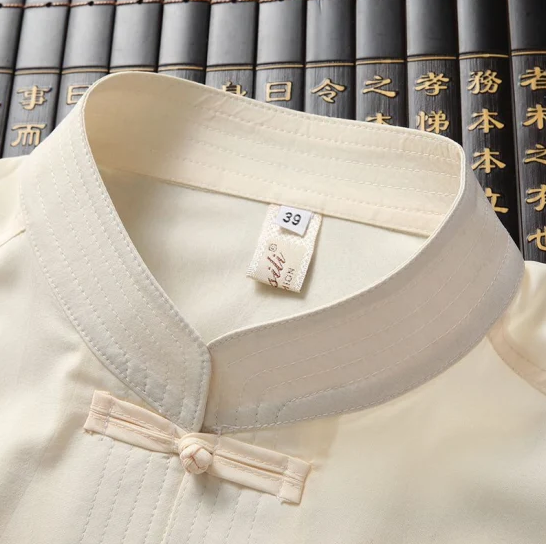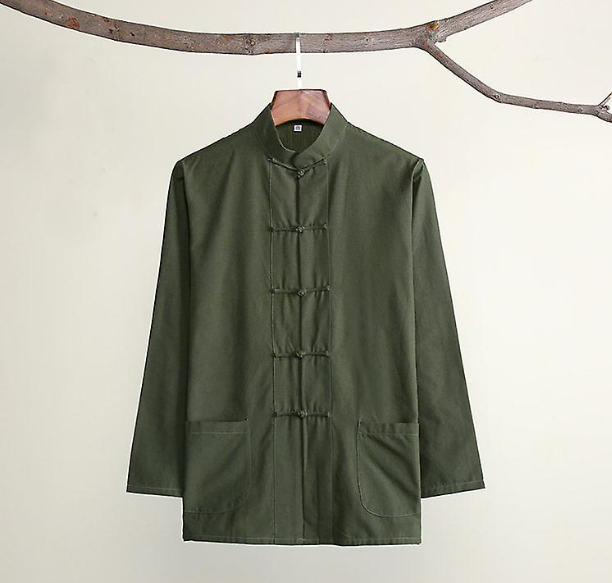Diverse collar styles in Tang suits include Mandarin, straight, slanted, and round collars, each reflecting unique cultural significance.
Overview of Tang Suit Collar Styles
The Tang suit, a traditional Chinese attire, stands out as a symbol of elegance and cultural heritage. Its unique charm largely derives from its diverse collar styles, each embodying a distinct historical and cultural significance. The collar in a Tang suit is not merely a functional part; it serves as a canvas reflecting the rich history of Chinese fashion.
Diversity of Collar Styles in Tang Suits
A journey through the array of collar styles in Tang suits reveals a fascinating aspect of China’s sartorial history. The Mandarin collar, known for its stand-up, round style, epitomizes sophistication and grace. Originating from the Qing Dynasty, it symbolized nobility and status. In contrast, the straight collar offers a more simplistic elegance, conveying practicality and straightforwardness, often preferred for everyday wear.
The slanted collar adds an asymmetrical flair to the garment, frequently seen in traditional and ceremonial Tang suits, blending artistic expression with cultural importance. The round collar, offering a softer look, often features in feminine designs and casual wear. These variations reflect deep cultural philosophies and social norms, where the choice of a collar style can indicate one’s social status, occupation, or philosophical beliefs. For instance, the upright design of the Mandarin collar links to Confucian ideals of modesty and restraint.

Impact of Collar Design on Overall Style of Tang Suits
The collar design profoundly influences the overall style of Tang suits, enhancing the wearer’s stature and aura. For example, the Mandarin collar creates a noble silhouette by elongating the neck. Conversely, a slanted collar introduces artistic asymmetry, adding dynamism to the outfit.
The collar style also dictates the suit’s appropriateness for various occasions. Tang suits with Mandarin collars suit formal events, symbolizing respect and solemnity, while round and straight collars are better for casual settings, offering comfort and ease.
The choice of collar impacts the fabric and embellishments used in the suit. Heavier fabrics like silk brocade pair well with stiffer collars like the Mandarin, whereas lighter materials like linen suit softer collars. The embroidery and decorative elements chosen also complement the collar style, enhancing the garment’s aesthetic appeal.
The diverse collar styles of Tang suits go beyond fashion statements; they narrate rich stories of Chinese culture and history. Each style carries its unique significance, adding to the traditional Chinese attire’s tapestry. Understanding these nuances deepens the appreciation for the art of wearing and admiring Tang suits.
Traditional Collar Styles in Tang Suits
The traditional collar styles of Tang suits, a quintessential part of Chinese heritage attire, offer a window into the rich tapestry of China’s cultural and historical fabric. These styles, ranging from the mandarin to the round collar, not only showcase aesthetic diversity but also reflect the intricate blend of functionality and cultural symbolism.
Mandarin Collar
The Mandarin collar, often regarded as the most iconic, stands out for its high, round neckline that fits closely around the neck. This style exudes an air of formality and elegance, and is closely linked to the garb of Chinese officials during the Qing Dynasty. The collar’s height varies, but it typically extends a couple of inches above the neckline, offering both warmth and modesty. Its popularity transcends borders, often appearing in modern fashion and military-style clothing.
Straight Collar
In contrast, the straight collar offers a more subtle and understated look. This collar lies flat against the body, running parallel to the shoulders. It represents simplicity and practicality, making it a common choice for everyday wear. The straight collar often features in Tang suits designed for ease of movement and comfort, catering to the daily needs of the wearer while maintaining a touch of traditional elegance.
Slanted Collar
The slanted collar presents a unique asymmetrical design, starting from one side of the shoulder and slanting diagonally across the chest. This style is a beautiful blend of traditional aesthetics and artistic expression. It’s often associated with more formal and ceremonial garments, adding a distinctive flair that sets it apart from more conventional designs. The slanted collar not only enhances the visual appeal but also symbolizes a break from conventionality, embracing a more dynamic and creative aspect of Chinese fashion.
Round Collar
The round collar, often seen as a softer and more approachable design, complements both formal and casual attire. This collar forms a gentle curve around the neck, without the stiffness of the Mandarin collar. It’s a popular choice for women’s Tang suits, offering a feminine touch and a comfortable fit. The round collar’s versatility and ease make it suitable for a wide range of occasions, from casual gatherings to more formal events.
Comparative Analysis
| Feature | Mandarin Collar | Straight Collar | Slanted Collar | Round Collar |
|---|---|---|---|---|
| Design | High, stand-up | Flat, parallel to shoulders | Asymmetrical, diagonal | Gentle curve around neck |
| Aesthetic | Formal, elegant | Simple, practical | Artistic, unique | Feminine, versatile |
| Cultural Significance | Symbol of nobility, formality | Everyday practicality | Break from tradition, creativity | Comfort and approachability |
| Popular Use | Formal wear, military styles | Daily wear, comfort-focused designs | Ceremonial attire, formal events | Women’s wear, both formal and casual |
| Material Suitability | Stiffer fabrics like silk brocade | Lighter, more flexible materials | Rich, decorative fabrics | A variety of fabrics, adaptable |
This table offers a comprehensive comparison of the four traditional collar styles in Tang suits, highlighting their unique design elements, aesthetic appeal, cultural significance, popular use, and material suitability. Each style, with its distinct characteristics, plays a crucial role in the rich diversity of traditional Chinese attire, making the Tang suit a timeless piece of cultural heritage.
Modern Adaptations of Tang Suit Collars
The evolution of Tang suit collars in the modern era exemplifies a perfect blend of tradition with contemporary fashion trends. This adaptation not only preserves the essence of traditional Chinese attire but also infuses it with a fresh, modern aesthetic, making the Tang suit relevant and appealing in today’s fashion landscape.
Modern Fusion in Collar Designs
Modern designers have ingeniously infused traditional Tang suit collars with contemporary elements, creating a fusion that resonates with the fashion-forward audience. This integration has led to innovative collar designs that retain traditional motifs while embracing modern style. For instance, some modern Tang suits feature a Mandarin collar with subtle western modifications, such as a slight reduction in height or incorporation of western-style buttons, enhancing comfort without compromising the classic elegance.
The introduction of new materials and textures in collar designs has also played a pivotal role in this modernization process. Designers now often use lighter, more adaptable fabrics, allowing for a more relaxed fit and increased comfort. These modern materials offer the flexibility to experiment with bolder, more avant-garde collar designs, such as asymmetrical cuts or integrated scarf-like collars, that challenge traditional norms while paying homage to the rich heritage of Tang suits.
Western Influences on Collar Styles
Western fashion has significantly influenced the evolution of Tang suit collars. Collar styles have been reimagined with a western twist, creating a fusion that is both unique and globally appealing. For example, some modern Tang suits adopt elements from the classic western suit collar, such as lapels or a notched design, blending them seamlessly with traditional Chinese aesthetics.
This cross-cultural exchange has not only diversified the range of Tang suit collars but has also broadened their appeal beyond traditional audiences. Western influences have introduced more diversity in terms of collar shapes and sizes, catering to a global market that values both heritage and innovation. These adaptations have allowed the Tang suit to transcend cultural boundaries, making it a versatile garment suitable for a variety of international settings and occasions.
Through these modern adaptations, the Tang suit collar has transformed from a symbol of traditional Chinese culture to a testament of global fashion fusion. This evolution showcases the dynamic and adaptable nature of cultural fashion, where tradition and modernity coexist in harmony, creating garments that are not only culturally significant but also relevant to contemporary fashion trends.

Functional and Cultural Significance of Collar Styles
The collar styles in Tang suits are not just fashion elements; they embody a deep intertwining of functionality and cultural symbolism. These styles, evolved over centuries, reflect the ingenuity of traditional Chinese attire, balancing practical needs with cultural expressions.
Practical Considerations of Different Collar Styles
When it comes to functionality, each collar style in a Tang suit serves specific practical purposes, catering to varying needs and preferences. The Mandarin collar, known for its snug fit, offers protection against the elements and has been traditionally favored in colder climates. Its upright structure also supports a dignified posture, making it ideal for formal occasions where an assertive presence is desired.
The straight collar, with its flat and open design, provides greater ventilation and ease of movement, making it a preferred choice in warmer conditions or for daily wear where comfort is paramount. Its simplicity also allows for easy maintenance and durability, a crucial aspect for everyday attire.
In contrast, the slanted collar, with its unique asymmetrical design, is not just an aesthetic choice but also a practical one. It enables easier dressing and undressing, an important consideration in traditional clothing that often lacked the convenience of modern fastenings.
The round collar, often softer and less structured, offers a comfortable option for a wide range of activities, from casual gatherings to more formal events. It accommodates various body types and movements with ease, ensuring both comfort and style.
Cultural and Historical Background of Each Collar Style
The cultural and historical significance of each collar style in Tang suits is profound. The Mandarin collar, for instance, is deeply rooted in China’s imperial history, often associated with the traditional garb of the Qing Dynasty’s bureaucrats. It symbolizes respect, power, and a connection to a revered past.
The straight collar, with its simpler design, reflects the values of practicality and modesty in traditional Chinese culture. It’s often seen in the clothing of the common people, symbolizing a life of simplicity and functionality.
The slanted collar, on the other hand, has origins in ancient Chinese clothing styles. It represents a fusion of aesthetics and functionality, often used in traditional costumes for important ceremonies and rituals. This style embodies a blend of artistic expression and cultural heritage.
The round collar carries connotations of femininity and approachability. It is a style that evolved over time, reflecting the changing status of women in Chinese society and their growing influence in fashion.
In conclusion, the collar styles of Tang suits are much more than just design elements; they are a vivid representation of Chinese history, culture, and societal values. Each style tells a unique story, making the Tang suit a garment rich in tradition and meaning. Understanding these collar styles offers insight into the intricate tapestry of Chinese cultural heritage, where fashion serves as a medium to express identity, tradition, and societal evolution.







